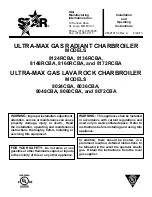
15
LP- 293 REV. 9.2.14
Failure to vent the appliance properly will result in serious personal injury or death.
Vents must be properly supported. Appliance exhaust and intake connections are not designed to carry heavy weight. Vent support
brackets must be within 1’ of the appliance and the balance at 4’ intervals. Appliance must be readily accessible for visual inspection for
the first 3’ from the appliance.
1. DIRECT VENT INSTALLATION OF EXHAUST VENT AND INTAKE PIPE
If installing a direct vent option, combustion air must be drawn from the outdoors directly into the appliance intake, and exhaust must
terminate outside. There are three basic direct vent options detailed in this manual: 1. Side Wall Venting, 2. Roof Venting, and 3.
Unbalanced Venting.
Be sure to locate the appliance such that the exhaust vent and intake piping can be routed through the building and properly
terminated. Different vent terminals can be used to simplify and eliminate multiple penetrations in the building structure (see Optional
Equipment in Venting Section). The exhaust vent and intake piping lengths, routing and termination methods must all comply with the
methods and limits given in the Venting section of this manual.
When installing a combustion air intake from outdoors, care must be taken to utilize uncontaminated combustion air.
NOTE: To
prevent combustion air contamination, see
Table 1
.
2. INDOOR COMBUSTION AIR INSTALLATION IN CONFINED OR UNCONFINED SPACE
This appliance requires fresh, uncontaminated air for safe operation and must be installed in a mechanical room where there is
adequate combustion and ventilating air.
NOTE: To prevent combustion air contamination, see
Table 1
.
Combustion air from the indoor space can be used if the space has adequate area or when air is provided through a duct or louver to
supply sufficient combustion air based on the appliance input.
Never obstruct the supply of combustion air to the appliance.
If the
appliance is installed in areas where indoor air is contaminated (see Table 1) it is imperative that the appliance be installed as direct
vent so that all combustion air is taken directly from the outdoors into the appliance intake connection.
Unconfined space
is space with volume greater than 50 cubic feet per 1,000 Btu/hour (4.8 cubic meters per kW) of the total input
rating of all fuel-burning appliances installed in that space. Rooms connected directly to this space, through openings not furnished with
doors, are considered part of the space.
Confined space
is space with volume less than 50 cubic feet per 1,000 Btu/hour (4.8 cubic meters per kW) of the total input rating of
all fuel-burning appliances installed in that space. Rooms connected directly to this space, through openings not furnished with doors,
are considered part of the space.
When drawing combustion air from inside a conventionally constructed building to a confined space, such space should be provided
with two permanent openings: one located 6” (15 cm) below the space ceiling, the other 6” (15cm) above the space floor. Each opening
should have a free area of one square inch per 1,000 Btu/hr (22cm
2
/kW) of the total input of all appliances in the space, but not less
than 100 square inches (645cm
2
).
If the confined space is within a building of tight construction, air for combustion must be obtained from the outdoors as outlined in the
Venting Section of this manual.
When drawing combustion air from the outside into the mechanical room, care must be taken to provide adequate freeze protection.
Do not attempt to vent this appliance by any means other than those described in this manual. Doing so will void the warranty, and may
result in severe personal injury or death.
Failure to provide an adequate fresh combustion air can cause poisonous flue gases to enter living space, which could result in severe
personal injury or death.
To prevent combustion air contamination, see
Table 1
.
F. PREVENT COMBUSTION AIR CONTAMINATION
Install intake piping for the boiler as described in the Venting section. Do not terminate exhaust in locations that can allow
contamination of intake air.
Summary of Contents for EL-110
Page 13: ...13 LP 293 REV 9 2 14 Figure 3 LP 285 B ...
Page 51: ...51 LP 293 REV 9 2 14 Figure 29 Cascade Master and Follower ...
Page 52: ...52 LP 293 REV 9 2 14 Figure 30 ...
Page 53: ...53 LP 293 REV 9 2 14 Figure 31 ...
Page 54: ...54 LP 293 REV 9 2 14 Figure 32 ...
Page 77: ...77 LP 293 REV 9 2 14 Figure 36 ...
Page 78: ...78 LP 293 REV 9 2 14 Figure 37 ...
Page 79: ...79 LP 293 REV 9 2 14 Figure 38 LP 293 A ...
Page 82: ...82 LP 293 REV 9 2 14 ...
Page 83: ...83 LP 293 REV 9 2 14 ...
















































